Documents: Go to download!
User Manual
- User Manual - (English, Spanish)
- Quick Specs - (English)
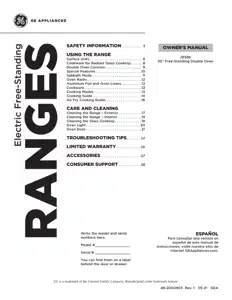
- USING THE RANGE
- CARE AND CLEANING
- TROUBLESHOOTING
Table of contents
Free-Standing Electric Double Oven Convection Range User's Manual
USING THE RANGE
CONTROL PANEL
Double Oven Controls

- Upper Oven and Lower Oven: Designates which oven the controls will operate.
- Convection Cooking Modes: Convection cooking modes use increased air circulation to improve performance. The type of benefit depends on the mode. Your oven has the following convection cooking modes: Convection Bake and Convection Roast. See the Cooking Modes section for more information.
- Traditional Cooking Modes: Your oven has the following traditional cooking modes: Bake, Broil, Hi/Lo and Warm.
- Steam Clean: See the Cleaning the Oven section for important information about using this mode.
- Start: Must be pressed to start any cooking, cleaning, or timed function.
- Cancel/Off: Cancels ALL oven operations except the clock and timer.
- Set Clock: Sets the oven clock time. Press and hold for 3 seconds. Use number pads to program the clock. Press Start to save the time.
- Timer: Works as a countdown timer. Press the Timer pad and the number pads to program the time in hours and minutes. Press the Start pad. If the oven is on, it will not turn off when the timer countdown is complete. To turn the timer off press the Timer pad.
- Delay Time: Delays when the oven will turn on. Use this to set a time when you want the oven to start. Press the Delay Time pad and use the number pads to program the time of day for the oven to turn on then press Start. Press the desired cooking mode and temperature then press Start. A Cook Time may also be programmed if desired. Follow the directions under Cook Time for setting this feature. This can only be used with Bake, Convection Bake, Convection Roast and Self-Clean. NOTE: When using the Delay Time feature, foods that spoil easily-such as milk, eggs, fish, stuffings, poultry and pork-should not be allowed to sit for more than 1 hour before or after cooking. Room temperature promotes the growth of harmful bacteria. Be sure that the oven light is off because heat from the bulb will speed harmful bacteria growth.
- Cook Time: Counts down cooking time and turns off the oven when the cooking time is complete. Press the Cook Time pad, use the number pads to program a cooking time in hours and minutes, then press Start. This can only be used with Bake, Convection Bake, and Convection Roast.
- Oven Light(s): Turn the oven light(s) on or off in both ovens. Note that lights in both ovens will not turn on if the door is opened while the other oven is in a clean mode.
- Lock Controls: Locks out the control so that pressing the pads does not activate the controls. Press and hold the Lock Controls pad for three seconds to lock or unlock the control. Cancel/Off is always active, even when the control is locked.
- Air Fry: Air Fry is a special, no-preheat, cooking mode that is designed to produce foods with a crispier exterior than traditional oven cooking. The Air Fry mode is intended for single rack cooking only
SPECIAL FEATURES
Adjust the Oven Temperature (OFFSEt)
This feature allows the oven baking and convection baking temperature to be adjusted up to 35ºF hotter or down to 35ºF cooler. Use this feature if you believe your oven temperature is too hot or too cold and wish to change it. This adjustment affects Bake and Convection Bake modes. No other cooking modes are affected.
Using the number pads to navigate as described above, select "OFFSEt". A number between positive and negative 35 will display. Use the 8 oror 3 pads to increase or decrease the offset value. Save and confirm by pressing the 0 pad.
End of Timer Signals (End tonE)
This is the tone that signals the end of a timer. The tone can be continuous (Con bEEP) or one repeating beep (bEEP). A continuous setting will continue to sound a tone until a button on the control is pressed.
Fahrenheit or Celsius Temperature Display (dEg Unit)
The oven control is set to use Fahrenheit temperatures (F) but you can change it to use Celsius temperatures (C).
Clock Configuration (Cloc cFg)
This feature specifies how the time of day will be displayed. You can select a standard 12-hour clock (12 H) or 24-hour military time (24 H).
Clock Display (Cloc diSP)
This feature specifies whether the clock appears in the display. It may be On or Off.
Auto Recipe Conversion (Auto rEciPE)
When using Convection Bake cooking, Auto Recipe Conversion will automatically convert the regular baking temperatures entered to convection bake cooking temperatures when turned on. Note that this option does not convert convection bake cooking times, it only converts temperatures. This feature may be turned On or Off.
Sound Volume (Sound)
This feature allows the oven tone volume to be adjusted between high (Hi), medium (Reg), low (lo), and off (Off).
The control will sound the oven tone at the new volume level each time the sound level is changed.
12-hour Shutoff (2H ShutoFF)
This feature shuts the oven down after 12 hours of continuous operation. It may be enabled or disabled.
OVEN RACKS
Recommended rack positions for various types of foods are provided in the Cooking Guide. Adjusting rack position is one way to impact cooking results. For example, if you would prefer darker tops on cakes, muffins, or cookies, try moving food one rack position higher. If you find foods are too brown on top try moving them down next time. When baking with multiple pans and on multiple racks, ensure there is at least 1½" between pans to allow sufficient space for air to flow. |
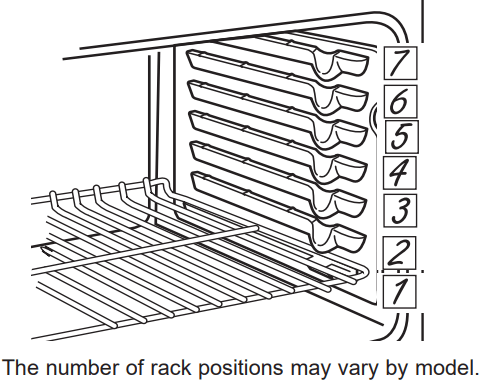
COOKWARE GUIDELINES
The material, finish, and size of cookware affect baking performance.
- Dark, coated and dull pans absorb heat more readily than light, shiny pans. Pans that absorb heat more readily can result in a browner, crisper, and thicker crust.
- If using dark and coated cookware check food earlier than minimum cook time. If undesirable results are obtained with this type of cookware consider reducing oven temperature by 25º F next time.
- Shiny pans can produce more evenly cooked baked goods such as cakes and cookies.
- Glass and ceramic pans heat slowly but retain heat well. These types of pans work well for dishes such as pies and custards.
- Air insulated pans heat slowly and can reduce bottom browning.
- Keep cookware clean to promote even heating.
COOKING MODES
Baking and Roasting Modes
Select a mode for baking and roasting based on the type and quantity of food you are preparing. When preparing baked goods such as cakes, cookies, and pastries always preheat the oven first. Follow recipe recommendations for food placement. If no guidelines are provided, center food in the oven.
Bake
The bake mode is intended for single rack cooking. This mode uses heat primarily from the lower element but also from the upper element to cook food. To use this mode press the Bake pad, enter a temperature, and then press Start. Preheating is generally recommended when using this mode.
Convection Bake Multi Rack
The Convection Bake Multi Rack mode is intended for baking on multiple racks at the same time. This mode uses heat primarily from the rear element, when available, but also heat from the upper and lower elements, along with air movement from the convection fan to enhance cooking evenness. Your oven is equipped with Auto Recipe Conversion, so it is not necessary to convert the temperature when using this mode. Baking time might be slightly longer for multiple racks than what would be expected for a single rack. To use this mode press the Convection Bake pad, enter a temperature, and then press Start. Always preheat when using this mode.
Convection Roast
The Convection Roast mode is intended for roasting whole cuts of meat on a single rack. This mode uses heat from the lower, upper, and rear elements, when available, along with air movement from the convection fan to improve browning and reduce cooking time. It is not necessary to convert temperature. Check food earlier than the recipe suggested time when using this mode or use a meat probe. To use this mode press the Convection Roast pad, enter a temperature, and then press Start. It is not necessary to preheat when using this mode.
Broiling Modes
The oven must be closed during broiling. Monitor food closely while broiling. Use caution when broiling on upper rack positions as placing food closer to the broil element increases smoking, spattering, and the possibility of fats igniting. For best performance center food below the broil heating element. Broiling on rack position 6 is not recommended.
Try broiling foods that you would normally grill. Adjust rack positions to adjust the intensity of the heat to the food. Place foods closer to the broil element when a seared surface and rare interior is desired. Thicker foods and foods that need to be cooked through should be broiled on a rack position farther from the broiler or by using Broil Lo.
Broil Hi
The Traditional Broil Hi mode uses intense heat from the upper element to sear foods. Use this function for thinner cuts of meat and/or foods you prefer less done on the interior. To use this mode press the Broil pad once and then press Start. It is not necessary to preheat when using this mode.
Broil Lo
The Traditional Broil Lo mode uses less intense heat from the upper element to cook food thoroughly while also producing surface browning. Use Broil Lo for thicker cuts of meat and/or foods you would like cooked all the way through. To use this mode press the Broil pad twice and then press Start. It is not necessary to preheat when using this mode.
Warm
Warm mode is designed to keep hot food hot, it is not intended to heat cold food. To use this mode, press the Warm pad then press Start. Preheating is not required. Cover foods that need to remain moist and do not cover foods that should be crisp. It is recommended, for food quality, that food not be kept warm for more than 2 hours.
OVEN COOKING GUIDE
Lower Oven for Double Oven Models
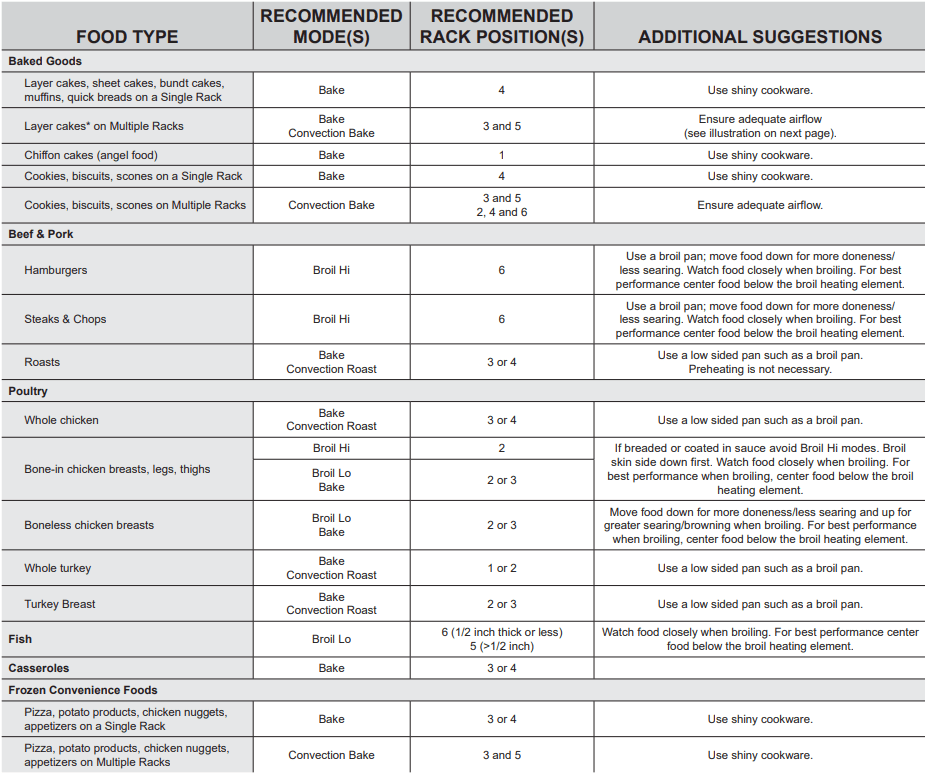
*When baking four cake layers at a time with traditional bake, use racks 3 and 5. *When baking four cake layers at a time with convection bake, use racks 2 and 5. Cook food thoroughly to help protect against food borne illness. Minimum safe food temperature recommendations for food safety can be found at IsItDoneYet.gov. Make sure to use a food thermometer to take food temperatures. | |
 Rack position for Traditional Bake, cakes in front of rack 3 and back of rack 5 | 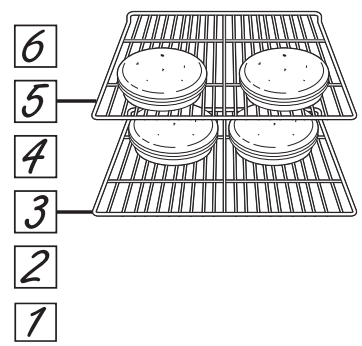 Rack position for Convection Bake, cakes in back of rack 3 and front of rack 5 |
Upper Oven for Double Oven Models
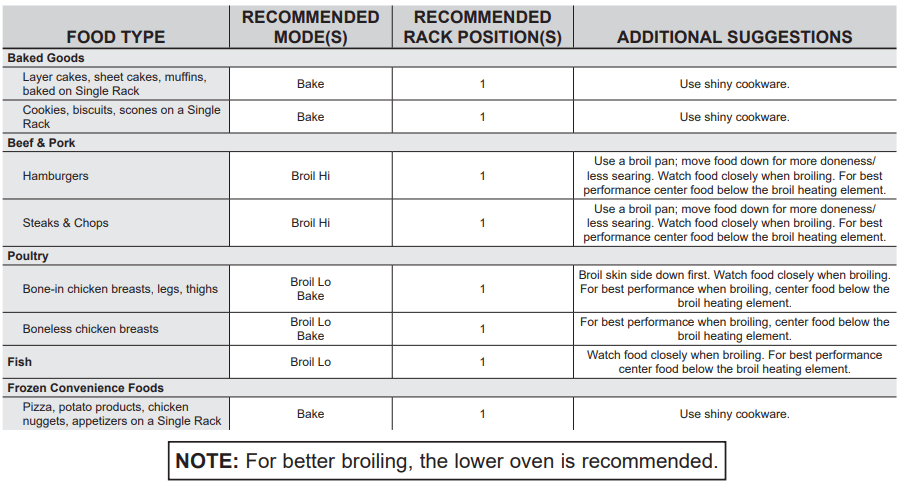
Air Fry Cooking Guide
Air Fry is a special, no-preheat, cooking mode that is designed to produce foods with a crispier exterior than traditional oven cooking. Select Air Fry, then input the desired set temperature and press Start. The temperature can be set between 300°F and 500°F.
Air Fry Cookware Guidelines
• Only use broil safe cookware when using Air Fry mode.
• A dark sheet pan is recommended. A dark pan promotes better browning and crisping.
• Oven baking baskets and baking grids can also be used. A sheet pan should be placed on the rack below the foods to catch any drippings when using a baking basket.

General Tips for Air Fry Mode
- The Air Fry mode is designed for cooking on a single rack.
- The Air Fry mode is designed to be used without preheating.
- Rack position 3 is recommended for most foods.
- Foods may cook faster than expected if the oven is already hot when food is placed in the oven.
- When air frying foods with sauce, it is recommended to apply the sauce at the end of cooking.
- If foods are browning too quickly, try a lower rack position or lower oven set temperature.
- For packaged foods, use traditional oven cooking instructions for set temperature and expected cook time.
- It is not necessary to flip or stir food during cooking
- Arrange food in a single layer on the pan, do not overload the pan.
- Always check internal food temperature to confirm minimum safe temperatures have been reached. Minimum safe food temperatures can be found on packages and at IsItDoneYet.gov.

CARE AND CLEANING
Cleaning the Range – Exterior
Control Knobs
The control knobs may be removed for easier cleaning. Make sure the knobs are in the OFF positions and pull them straight off the stems for cleaning.
The knobs can be washed with soap and water. Make sure the inside of the knobs are dry before replacing. Replace the knobs, in the OFF position to ensure proper placement.
Control Lockout
If desired, the touch pads may be deactivated before cleaning.
- Clean up splatters with a damp cloth.
- You may also use a glass cleaner.
- Remove heavier soil with warm, soapy water. Do not use abrasives of any kind. Reactivate the touch pads after cleaning.
Control Panel
It’s a good idea to wipe the control panel after each use. Clean with mild soap and water or vinegar and water, rinse with clean water and polish dry with a soft cloth.
Do not use abrasive cleansers, strong liquid cleansers, plastic scouring pads or oven cleaners on the control panel - they will damage the finish.
Oven Exterior
Do not use oven cleaners, abrasive cleansers, strong liquid cleansers, steel wool, plastic scouring pads, or cleaning powders on the exterior of the oven. Clean with a mild soap and water or vinegar and water solution. Rinse with clean water and dry with a soft cloth. When cleaning surfaces, make sure that they are at room temperature and not in direct sunlight.
Do not use commercial oven cleaners, cleaning powders, steel wool or harsh abrasives on any painted surface.
Stainless Steel Surfaces
Do not use a steel wool pad; it will scratch the surface. To clean the stainless steel surface, use warm sudsy water or a stainless steel cleaner or polish. Always wipe the surface in the direction of the grain. Follow the cleaner instructions for cleaning the stainless steel surface. Cleaners with oxalic acid such as Bar Keepers Friend Soft Cleanser™ will remove surface rust, tarnish and small blemishes. Use only a liquid cleanser free of grit and rub in the direction of the brush lines with a damp, soft sponge. To inquire about purchasing cleaning products including stainless steel appliance cleaner or polish, see the Accessories and Consumer Support sections at the end of this manual.
Porcelain Enamel Cooktop
The porcelain enamel finish is sturdy but breakable if misused. This finish is acid-resistant. However, any acidic foods spilled, should not be permitted to remain on the finish.
The porcelain enamel finish is sturdy but breakable if misused. This finish is acid-resistant. However, any acidic foods spilled (such as fruit juices, tomato or vinegar) should not be permitted to remain on the finish.
If acids spill on the cooktop while it is hot, use a dry paper towel or cloth to wipe it up right away. When the surface has cooled, wash with soap and water. Rinse well.
For other spills such as fat spatterings, wash with soap and water or cleansing powders after the surface has cooled. Rinse well. Polish with a dry cloth.
The interior of your new oven can be cleaned manually or by using Steam Clean or Self Clean modes. Spillage of marinades, fruit juices, tomato sauces and basting liquids containing acids may cause discoloration and should be wiped up immediately. Let hot surfaces cool, then clean and rinse.
Cleaning The Oven - Interior
Manual Cleaning
Do not use oven cleaners, abrasive cleaners, strong liquid cleansers, steel wool, scouring pads, or cleaning powders on the interior of the oven. Clean with a mild soap and water or vinegar and water solution. Rinse with clean water and dry with a soft cloth. When cleaning surfaces, make sure that they are at room temperature.
Steam Clean Mode
Steam clean is intended to clean small spills using water and a lower cleaning temperature than Self-Clean. To use the Steam Clean feature, wipe grease and soils from the oven. Pour one cup of water into the bottom of the oven. Close the door. Press the Steam Clean pad and then press Start. The oven door will lock. Do not open the door during the 30 minute steam clean as this will decrease the steam clean performance. At the end of the steam clean cycle the door will unlock. Wipe out any excess water and any remaining soil.
Racks
All racks can be washed with warm, soapy water. Elements (not shiny) racks can be left in the cavity during self clean.
Racks may be more difficult to slide, especially after a self-clean. Put some vegetable oil on a soft cloth or paper towel and rub onto the left and right edges.
NOTE: Using other cooking oils will cause a discoloring or a rust like color residue on the racks and cavity sides. To clean this residue, use a soap and water or a vinegar and water solution. Rinse with clean water and dry with a soft cloth
Oven Heating Elements
Do not clean the bake element or the broil element. Any soil will burn off when the elements are heated. To clean the oven floor, gently lift the bake element. Clean the oven floor with warm, soapy water. | 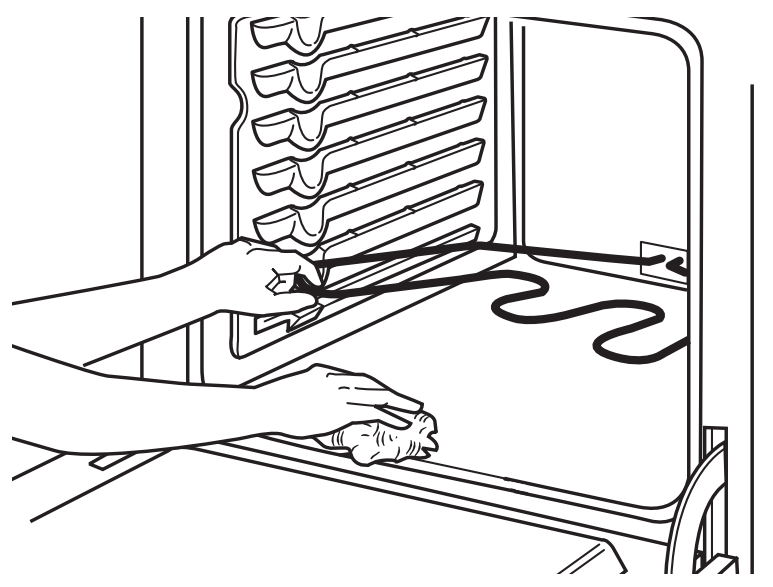 Gently lift the bake element Wipe up heavy soil on the oven bottom. |
Cleaning the Glass Cooktop
Normal Daily Use Cleaning
To maintain and protect the surface of your glass cooktop, follow these steps:
NOTE: It is very important that DO NOT heat the cooktop until it has been cleaned thoroughly. |
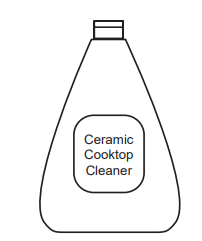 Clean your cooktop after each spill. Use ceramic cooktop cleaner . |
Burned-On Residue
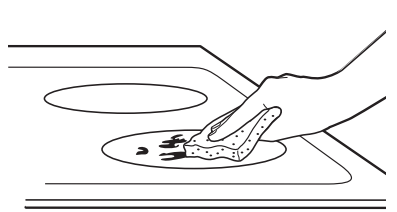
Use cleaning pad for ceramic cooktops
1. Allow the cooktop to cool.
2. Spread a few drops of ceramic cooktop cleaner on the entire burned residue area.
3. Using a non-scratch cleaning pad for ceramic cooktops, rub the residue area, applying pressure as needed.
4. If any residue remains, repeat the steps listed above as needed.
5. For additional protection, after all residue has been removed, polish the entire surface with ceramic cooktop cleaner and a paper towel.
Heavy, Burned-On Residue
1. Allow the cooktop to cool.
2. Use a 45° angle against the glass surface and scrape the soil. It will be necessary to apply pressure to the razor scraper in order to remove the residue.
3. After scraping with the razor scraper, spread a few drops of Ceramic Cooktop Cleaner on the entire burned residue area. Use a non-scratch cleaning pad to remove any remaining residue.
4. For additional protection, after all residue has been removed, polish the entire surface with Ceramic Cooktop Cleaner and a paper towel.
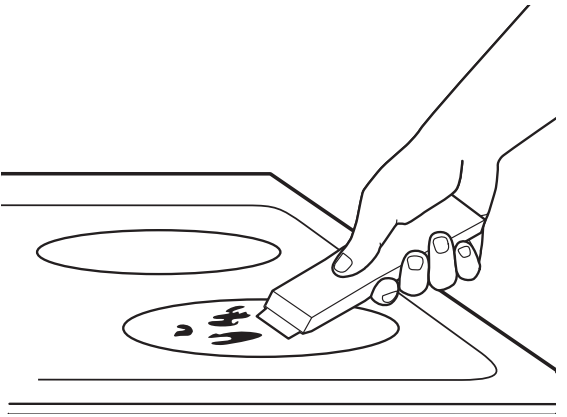 | The ceramic cooktop scraper and all recommended supplies are available through our Parts Center. See the Accessories and Consumer Support sections at the end of this manual. NOTE: Do not use a dull or nicked blade. |
Metal Marks and Scratches
1. Be careful not to slide pots and pans across your cooktop. It will leave metal markings on the cooktop surface.
- These marks are removable using the ceramic cooktop cleaner with a non-scratch cleaning pad for ceramic cooktops.
2. If pots with a thin overlay of aluminum or copper are allowed to boil dry, the overlay may leave black discoloration on the cooktop.
- This should be removed immediately before heating again or the discoloration may be permanent.
NOTE: Carefully check the bottom of pans for roughness that would scratch the cooktop.
Damage from Sugary Spills and Melted Plastic
- Turn off all surface units. Remove hot pans.
- Wearing an oven mitt:
- Use a single-edge razor blade scraper to move the spill to a cool area on the cooktop.
- Remove the spill with paper towels.
- Any remaining spillover should be left until the surface of the cooktop has cooled.
- Don't use the surface units again until all of the residue has been completely removed.
NOTE: If pitting or indentation in the glass surface has already occurred, the cooktop glass will have to be replaced. In this case, service will be necessary.
Oven Light
WARNING
SHOCK OR BURN HAZARD: Before replacing oven light bulb, disconnect the electrical power to the range at the main fuse or circuit breaker panel. Failure to do so may result in electric shock or burn.
CAUTION
BURN HAZARD: The glass cover and bulb should be removed when cool. Touching hot glass with bare hands or a damp cloth can cause burns.
Oven Light Replacement (on some models)

To Remove:
- Turn the glass cover counterclockwise ¼ turn until the tabs of the glass cover clear the grooves of the socket. Wearing latex gloves may offer a better grip.
- Remove the bulb by pulling it straight out.
To replace:
- Use a 120/130 volt halogen bulb, not to exceed 50 watts. Replace the bulb with the same type of bulb that was removed. Be sure the replacement bulb is rated 120 volts or 130 volts (NOT 12 volts).
- Using gloves or a dry cloth, remove the bulb of from its packaging. Do not touch the bulb with bare fingers. Oil from skin will damage the bulb and shorten its life.
- Push the bulb straight into the receptacle all the way.
- Place the tabs of the glass cover into the grooves of the socket. Turn the glass cover clockwise ¼ turn. For improved lighting inside the oven, clean the glass cover frequently using a wet cloth. This should be done when the oven is completely cool.
- Reconnect electrical power to the oven
Oven Door
Lift-Off Upper Oven Door
To remove the door:
- Fully open the door.
- Lift up on the hinge lock toward the oven frame until they stop.
- Close the door to 45 degrees (you will feel the door stop). The hinge lock will contact the oven frame.
- On both sides of the door, press down on the release buttons on each hinge.
- Lift door up until it is clear of the hinge.
- Pull on hinge arms slightly to relieve pressure on the locking tabs.
- Push the hinge locks down onto the hinge.
- Push the hinges in toward the unit so they are closed.
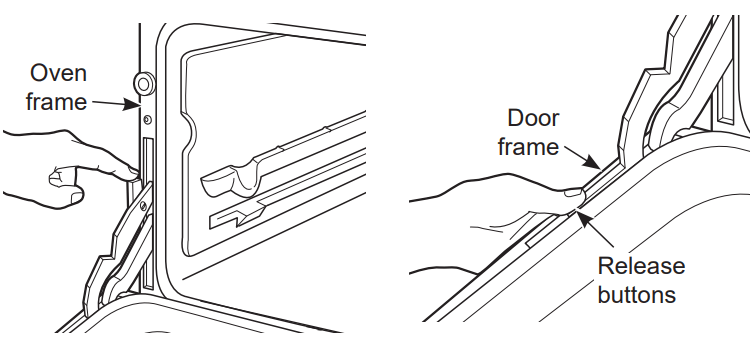
To replace the door:
- Pull the hinges down away from the oven frame to the fully open position.
- Lift up on the hinge locks toward the oven frame until they stop.
- The hinges will release to the 45-degree position. The hinge locks will contact the oven frame.
- Slide the door back onto the hinges. Make sure the buttons pop back out.
- Fully open the door.
- Push the hinge locks down onto the hinge.
- Close the oven door.
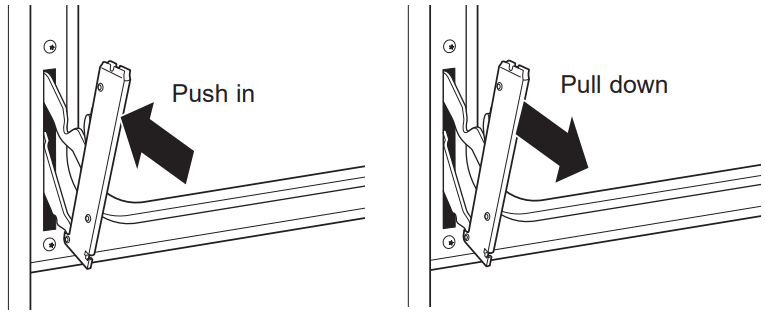
Lift-Off Lower Oven Door
To remove the door:
- Fully open the door.
- Pull the hinge locks down toward the door frame, to the unlocked position. A tool, such as a small flatblade screwdriver, may be required.
- Firmly grasp both sides of the door at the top.
- Close door to the door removal position. The door should be open approximately 3" with no obstruction above the door.
- Lift door up and out until both hinge arms are clear of the slots.
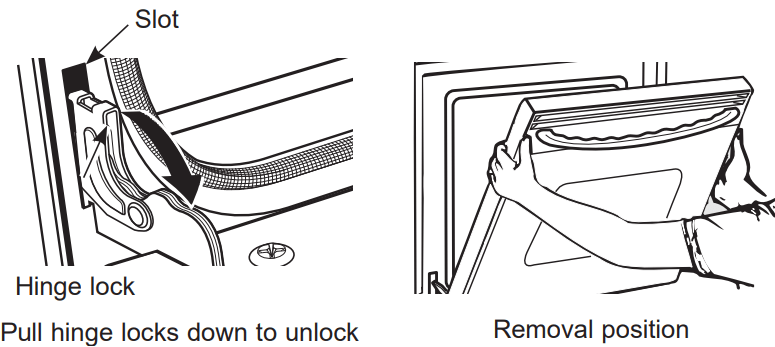
To replace the door:
1. Firmly grasp both sides of the door at the top.
2. Starting on the left side, with the door at the same angle as the removal position, seat the indentation of the hinge arm into the bottom edge of the hinge slot. The notch in the hinge arm must be fully seated into the bottom of the slot. Repeat for right side.
3. Fully open the door. If the door will not fully open, the indentation is not seated correctly in the bottom edge of the slot.
4. Push the hinge locks up against the front frame of the oven cavity, to the locked position.
5. Close the oven door.

TROUBLESHOOTING
Problem | Possible Cause | What To Do |
|---|---|---|
Surface units will not maintain a rolling boil or cooking is not fast enough | Improper cookware being used. | Use pans which are flat and match the diameter of the surface unit selected. |
In some areas, the power (voltage) may be low. | Cover pan with a lid until desired heat is obtained. | |
Surface units do not work properly | A fuse in your home may be blown or the circuit breaker tripped. | Replace the fuse or reset the circuit breaker. |
Cooktop controls improperly set. | Check to see the correct control is set for the surface unit you are using. | |
Surface unit stops glowing when turned to a lower setting | The unit is still on and hot. | This is normal. |
Scratches (may appear as cracks) on cooktop glass surface | Incorrect cleaning methods being used. | Scratches are not removable. Tiny scratches will become less visible in time as a result of cleaning. |
Cookware with rough bottoms being used or coarse particles (salt or sand) were between the cookware and the surface of the cooktop. Cookware has been slid across the cooktop surface. | To avoid scratches, use the recommended cleaning procedures. Make sure bottoms of cookware are clean before use, and use cookware with smooth bottoms. | |
Areas of discoloration on the cooktop | Food spillovers not cleaned before next use. | See the Cleaning the glass cooktop section. |
Hot surface on a model with a light-colored cooktop. | This is normal. The surface may appear discolored when it is hot. This is temporary and will disappear as the glass cools. | |
Plastic melted to the surface | Hot cooktop came into contact with plastic placed on the hot cooktop. | See the Glass surface—potential for permanent damage section in the Cleaning the glass cooktop section. |
Pitting (or indentation) of the cooktop | Hot sugar mixture spilled on the cooktop. | Call a qualified technician for replacement. |
Frequent cycling off and on of surface units | Improper cookware being used. | Use only flat cookware to minimize cycling. |
My new oven doesn't cook like my old one. Is something wrong with the temperature settings? | Your new oven has a different cooking system from your old oven and therefore may cook differently than your old oven. | For the first few uses, follow your recipe times and temperatures carefully. If you still think your new oven is too hot or too cold, you can adjust the temperature yourself to meet your specific cooking preference. See the Special Features section. NOTE: This adjustment affects Bake, and Convection Bake temperatures; it will not affect Convection Roast, Broil or Clean. |
Food does not bake properly | Oven controls improperly set. | See the Cooking Modes section. |
Rack position is incorrect or rack is not level. | See the Cooking Modes section and Cooking Guide. | |
Incorrect cookware or cookware of improper size being used. | See the Cookware section. | |
Oven temperature needs adjustment. | See the Special Features section. | |
Ingredient substitution | Substituting ingredients can change the recipe outcome. | |
Food does not broil properly | Oven controls improperly set. | Make sure you select the appropriate broil mode. |
Improper rack position being used. | See Cooking Guide for rack location suggestions. | |
Food being cooked in a hot pan. | Make sure cookware is cool. | |
Cookware not suited for broiling. | Use a pan specifically designed for broiling. | |
Aluminum foil used on the broiling pan and grid has not been fitted properly and slit as recommended. | If using aluminum foil conform to pan slits. | |
In some areas the power (voltage) may be low. | Preheat the broil element for 10 minutes. | |
Oven temperature too hot or too cold | Oven temperature needs adjustment. | See the Special Features section. |
Oven does not work or appears not to work | A fuse in your home may be blown or the circuit breaker tripped. | Replace the fuse or reset the circuit breaker. |
Oven controls improperly set. | See the Using the Oven section. | |
Oven is in Sabbath Mode. | Verify, that the oven is not in Sabbath Mode. See the Special Features section. | |
“Crackling” or “popping” sound | This is the sound of the metal heating and cooling during both the cooking and cleaning functions. | This is normal. |
Why is my range making a "clicking" noise when using my oven? | Your range cycles the heating elements by turning relays on and off to maintain the oven temperature. | This is normal. |
Clock and timer do not work | A fuse in your home may be blown or the circuit breaker tripped. | Replace the fuse or reset the circuit breaker. |
Plug on range is not completely inserted in the electrical outlet. | Make sure electrical plug is plugged into a live, properly grounded outlet. | |
Oven controls improperly set. | See the Using the kitchen timer section. | |
Oven door is crooked | The door is out of position. | Because the oven door is removable, it sometimes gets out of position during installation. To straighten the door, re-install the door. See the "Lift-Off Oven Door" instructions in the "Care and Cleaning" section. |
Oven light does not work | Light bulb is loose or defective. | Tighten or replace bulb. |
Pad operating light is broken. | Call for service. | |
Oven will not steam clean. | Display flashes HOT. | Allow the oven to cool to room temperature and reset the controls. |
Oven controls improperly set. | See the Using Steam Clean section. | |
Oven door is not closed. | Make sure you close the door to start steam clean cycle. | |
Excessive smoking during clean cycle | Excessive soil or grease. | Press the Cancel/Off pad. Open the windows to rid the room of smoke. Wait until the LOCKED light goes off. Wipe up the excess soil and reset the clean cycle. |
Excessive smoking during broiling | Food too close to burner element. | Lower the rack position of the food. |
Oven door will not open after a clean cycle | Oven too hot. | Allow the oven to cool below locking temperature. |
Oven not clean after a clean cycle | Oven controls improperly set. | See the Cleaning the Oven section. |
Oven was heavily soiled. | Clean up heavy spillovers before starting the clean cycle. Heavily soiled ovens may need to clean again or for a longer period of time. | |
DOOR LOCK i light is on when you want to cook | The oven door is locked because the temperature inside the oven has not dropped below the locking temperature. | Press the Cancel/Off pad. Allow the oven to cool. |
| “F— and a number or letter” flash in the display | You have a function error code. | Press the Cancel/Off pad. Allow the oven to cool for one hour. Put the oven back into operation. |
If the function code repeats. | Disconnect all power to the oven for at least 30 seconds and then reconnect power. If the function error code repeats, call for service. | |
| Display goes blank | A fuse in your home may be blown or the circuit breaker tripped. | Replace the fuse or reset the circuit breaker. |
The clock is turned off. | See the Special features section. | |
Oven is in Sabbath Mode. | Verify that the oven is not in Sabbath Mode. See the Special Features section. | |
| Power outage, clock flashes | Power outage or surge | Reset the clock. If the oven was in use, you must reset it by pressing the Cancel/Off pad, setting the clock and resetting any cooking function. |
| “Burning” or “oily” odor emitting from the vent | This is normal in a new oven and will disappear in time. | To speed the process, set a self-clean cycle for a minimum of 3 hours. See the Cleaning the Oven section. |
| Strong odor | An odor from the insulation around the inside of the oven is normal for the first few times the oven is used. | This is temporary and will go away after several uses or a self-clean cycle. |
| Fan noise | A convection fan may automatically turn on and off. | This is normal. The fan is designed to operate intermittently to maximize cooking evenness. The convection fan will operate during preheat of the bake cycle. The fan will turn off after the oven is heated to the set temperature. This is normal. |
| My oven door glass appears to be "tinted" or have a "rainbow" color. Is this defective? | No. The inner oven glass is coated with a heat barrier to reflect the heat back into the oven to prevent heat loss and keep the outer door cool while baking. | This is normal. Under certain light or angles, you may see this tint or rainbow color. |
| Sometimes the oven takes longer to preheat to the same temperature | Cookware or food in oven. | The cookware or food in the oven will cause the oven to take longer to preheat. Remove items to reduce preheat time. |
Number of racks in oven. | Adding more racks to the oven will cause the oven to take longer to preheat. Remove some racks. | |
Different cooking modes. | The different cooking modes use different preheat methods to heat the oven for the specific cooking mode. Some modes will take longer than others (i.e. convection bake). | |
| Display flashes | Power failure. | Reset the clock. |
| Unable to get the display to show “SF” | Oven control pads were not touched properly. | The Broil Hi/Lo and Bake pads must be touched at the same time and held for 3 seconds. |
| Control signals after entering cooking time or start time | You forgot to enter a bake temperature or cleaning time. | Touch the Bake pad and desired temperature or the SELF Clean pad and desired clean time. |
| Oven racks are difficult to slide | The shiny, silver-colored racks were cleaned in a self-clean cycle. | Apply a small amount of vegetable oil to a paper towel and wipe the edges of the oven racks with the paper towel. Do not spray with Pam® or other lubricant sprays. |
| Steam from the vent | When using the ovens, it is normal to see steam coming out of the oven vents. As the number of racks or amount of food being cooked increases, the amount of visible steam will increase. | This is normal. |
| Oven will not stay set. | Function error. | Disconnect all power for at least 30 seconds and then reconnect power. If repeating, call for service. |
| Water remaining on oven floor after Steam Clean cycle | This is normal. | Remove any remaining water with a dry cloth or sponge. |
See other models: 18027 3-Way GTS18HGNERWW GDT530PGP5WW GZS22IYNRHFS
